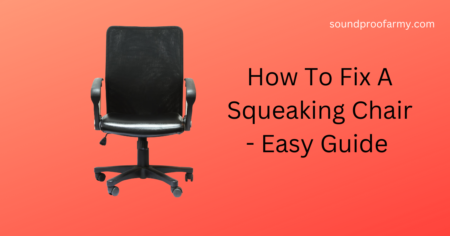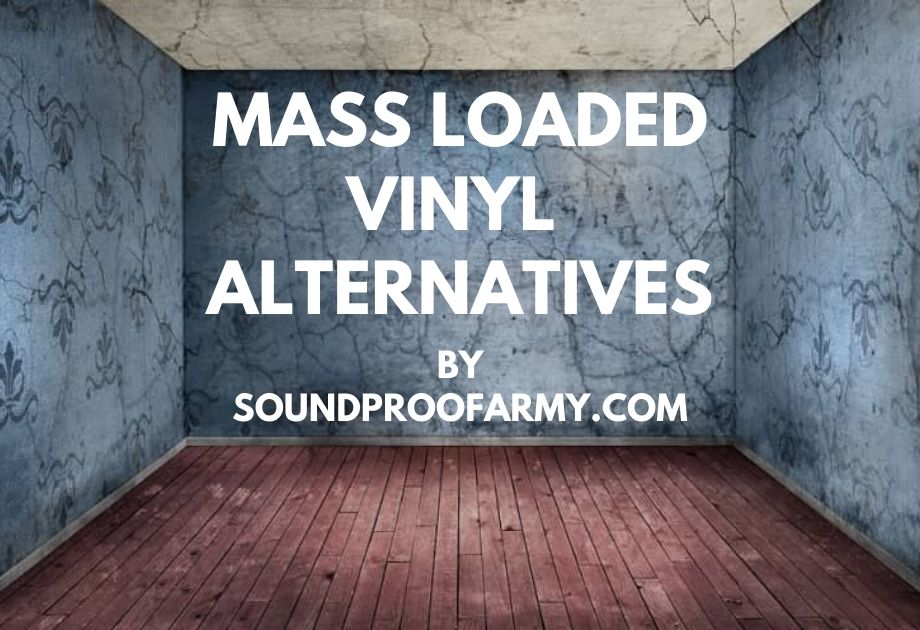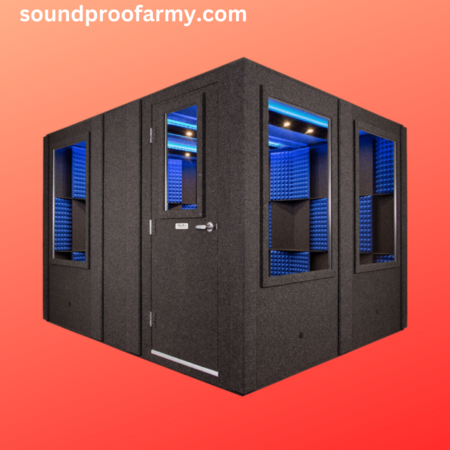Soundproofing Paint is a very popular means of soundproofing walls, ceilings, and other surfaces. Today we will discuss, does acoustic coat paint actually work.
Acoustic coats do works. It works in two ways, first, it blocks the sound that comes into your living place and also blocks the internal sounds to go out of your place. It can be applied on any surface from floors, walls, ceilings, doorways, and even windows!
The product also comes in different colors so there’s no need for you to cover up those beautiful hardwood floors with ugly brown carpet padding just to get some peace and quiet while watching your favorite TV show.
But does this stuff really work? That’s what we shall find out.
Table of Contents
What is Soundproofing Paint Made of?
The acoustic coat materials are mixed with water and then sprayed onto the surface you want to cover up.
This process creates an acoustical barrier over your walls or ceiling so that unwanted noise cannot pass through it.
The major difference is its thickness, due to the sound-absorbing fillers and ceramic microspheres inside.
The contents also include thermals (tiny vacuum-sealed cells) which make up a significant portion of the material’s noise reduction capability.
Does Soundproofing Paint Work?
The acoustic coat soundproofing paint works by absorbing the sound waves that exist in your room.
By absorbing these waves, it muffles the noise and doesn’t allow them to bounce off of any walls or furniture in your space.
Soundproofing paints work similarly to soundproof wallpapers or acoustic foam panels but instead absorb sound waves rather than reflecting them back like a mirror does with light.
You can find acoustic coat paint at most hardware stores such as Home Depot for about $20-$40 per gallon on average depending on what type you buy.
However, this product is often not worth its price because it must be applied over drywall.
Acoustic coat soundproofing paint is only effective in small areas because it must be continually applied and reapplied to dampen the acoustics of a room.
This soundproofing paint may work for rooms that are on the smaller side, but not larger than 300 square feet.
Sound dampening paint is also effective in reducing noise because it absorbs acoustics by filling up empty space.
However, this type of acoustic coat paint doesn’t come with a peelable backing and requires at least three coats to be applied before it becomes dry enough to use as a wallpaper or basecoat (e.g., acoustical foam panels).
Acoustic sounds are dampened by this paint because they act like sponges.
Over time, the wall will become saturated with sound and therefore have deadened sound waves.
I would like to point out that while this product performs well on some medium-frequency noises, it cannot block bass or other types of noise.
such as:
- Traffic noise.
- Loud stereo/ television
- Barking dog
- A drum room will not be soundproofed. But it will improve the acoustic quality of the audio.
What Is the Best Soundproofing Paint?
Sound-absorbing paint is a good way to deal with medium-frequency sounds.
One example of sound-absorbing paint is the Acoustic Sound Deadening Paint, which can bring about up to a 30% reduction in sound from this frequency level according to manufacturer details.
As a soundproofing material, acoustic coat paint is less effective than the more expensive and labor-intensive sound-deadening wallpapers or acoustic foam panels.
Sound absorbing paints work through many different mechanisms:
In general, these materials will absorb some of the noise that is generated from certain sources such as traffic or trains.
However, this product doesn’t soundproof but instead works similarly as soundproofing wallpapers or acoustic foam panels.
To apply this sound-deadening paint, you need a brush and roller. But it is different from your regular paint.
The paint is thick and it does not spread like normal paint. It takes two to three coats of sound-deadening paint for it to work well.
This means that you should plan for how much you need in advance so you do not run out of stuff before finishing your project.
Materials that Complement Soundproofing Paint
There are a variety of sound-deadening materials that can all have a significant impact on noise reduction.
they include:
Acoustic Sealants
The acoustic sealant will not only keep air from escaping but also provide an excellent sound barrier. It can be applied to walls as well.
This acoustic paint could work similarly to acoustical foam panels or wallpaper in some cases where it would act as a membrane between two solid surfaces.
Such as next to your window at home or any other room with high noise levels coming from outside sources.
When installed correctly, acoustic coat soundproofing paint can reduce ambient sounds by up to 30%.
An example is a green glue acoustic sealant that can be used to help block noise.
Green Glue is an acoustical sealant that helps to block sound by attaching the joints and seams of windows, doors, or any other type of opening.
Mass Loaded Vinyl
Mass-loaded vinyl is a cost-effective option that offers effective noise and sound reduction for various applications on walls and ceilings.
Applied to acoustically sensitive surfaces, mass-loaded vinyl can reduce sound transmission by up to 50%.
The acoustic performance is especially good when applied to acoustically reflective walls.
Types of Mass Loaded Vinyl:
There are two types of Mass loaded vinyl – Echo Buster and Sonex Acoustic Barrier.
They both use the same innovative system which traps air molecules for a more effective barrier against airborne noise and vibration.
Both products offer an excellent cost-to-performance ratio at only $0.75 per square foot installed.
Curtains
You can use weatherstrip tape with sound-dampening curtains to reduce the amount of outside noise that seeps in through the window.
Unlike regular curtains, sound dampening curtains are made from thick and dense material.
Their goal is not to keep noise out completely but rather to reduce it as much as possible.
Sound dampening curtains also come in a variety of colors and patterns to match your home’s décor.
Household Items
One example of reducing the noise you hear from an adjacent neighbor is by moving heavy furniture against the shared wall.
This will create a sound barrier that reduces the noise that your neighbor can hear.
Lastly, we have glass wool insulation panels.
These are great for reducing unwanted sounds within your home too but don’t do much about noise from outdoors unless they’re used as acoustical ceilings inside rooms with high ceilings (like basements).
It’s best to use these products anywhere though since it creates a more acoustically friendly environment.
Soundproof Drywall
Soundproof drywall is much more effective than acoustic paint (although it technically isn’t soundproof).
To get the best sound reduction results, sandwich green glue or mass-loaded vinyl between layers of your drywall boards.
One of my favorite brands of drywall sheets is Quietrock.
The installation of soundproof drywall will cost you anywhere between $400 and $2000, depending on the thickness of your boards.
Weather Stripping
Weatherstrips are not going to soundproof your wall, but they will seal up gaps in your window and door frame.
With the weatherstrips, airborne sound can’t get into the room.
If you’re using acoustic coat paint, then the weather stripping is going to help soundproof your room.
Weatherstrips are low-cost and easy to install on a door or window frame.
If noise from driving or other things in the corridor is a problem, then put weather stripping.
It is one of the best materials to make things quieter.
Final thoughts on Soundproofing Paint
Soundproofing Paint can be used as one of the many DIY soundproofing projects in your home.
The acoustic paint is the perfect solution to soundproofing your walls or ceiling, but it will not work as well as acoustic foam panels and can be quite expensive.
Soundproof Paint does have its advantages because you are able to apply this product right where you need it – on the wall that needs more soundproofing.
Acoustic coat acoustical sealant also helps in preventing air leaks and drafts from entering through cracks in a home’s exterior siding or joints of windows, doors, etc.
If you want to make a room soundproof, then you should use drywall, mass-loaded vinyl, and acoustic sealants such as green glue.
If you want to improve the audio quality in a room, then you can use acoustic paint or foam panels.
Frequently Asked Questions
Is there a paint that reduces noise?
No, but there are paints that help to reduce the noise and reduce its echoes.
You can use acoustic paint, or acoustic foam panels to help improve your sound quality in a room.
Alternatively, you can use acoustical sealants such as green glue.
Can you get soundproof paint?
No, soundproofing paint does not exist.
You can use acoustic paint, or acoustic foam panels to help improve your sound quality in a room.
Alternatively, you could use acoustical sealants such as green glue.
How can I soundproof a room cheaply?
If you want to soundproof a room cheaply, then there are a few things to take into consideration.
If you have an old house and it has potential air leaks that could be the source of your noise problem, then you’ll need to check for those first.
You should also seal up any cracks or gaps in the window frames and door frames as these will also contribute to the amount of noise that is heard inside your room.
If possible, adding some insulation in the attic and walls can also help reduce noise from outside sources.
How expensive is soundproof paint?
Soundproofing paint is not that expensive. It is a relatively cheap product that can help to reduce the noise in a room.
If you are looking for something cheaper, then acoustic wallpaper or foam panels would be more cost-effective.














